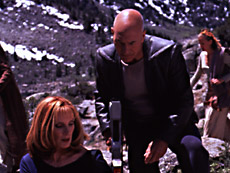While lighting the Son'a spaceship interiors, Leonetti took a slightly divergent tactic. He first conferred with production designer Zimmerman, who decided to differentiate the alien cruisers by patterning their walls with a series of holes some 5" in diameter. Leonetti backed these with 1000 H paper, through which he aimed 1K nook lights gelled with a shade of steel blue. He also opted for harsh overhead lighting in order to accent the decrepit condition of the Son'a skin. "We purposely kept top light on the Son'a to accentuate their aging — it shadowed and emphasized their wrinkles," the cameraman explains. "We also used white light [from the top] instead of blue because it wouldn't look right to have a bunch of blue-faced aliens running around the ship. At one point, though we did have a very light blue gel on the ceilings, so that there was light blue sheen [in the area] when we photographed them. We had discussed having three gradations of blue: a deep blue on the bottom part of the wall; a lighter blue two-thirds of the way up; and then an even whiter blue on the ceiling. But when we changed the light [in that manner], the blue became too strong."
This indigo palette carried through to the Son'a science ship's Energy Collector, an immense oblong-shaped arena with a hollow core, where Picard engages Ru'afo in a hand-to-hand struggle while attempting to disarm the deadly device. Situated on Paramount's Stage 18, the Collector had a symmetrical shape, but to create its lighting, Leonetti requested that only half the set be constructed completely; the reverses were done by shooting the set after its paneling and instrumentation had been redressed. The Collector set was 50' high, 80' long and 40' wide, and consisted of an intricate honeycomb of triangular steel grids with welded seams. "We left one end of the set open — a section probably about 30' wide from top to bottom — and wrapped the rest of it in gray muslin," Leonetti says. "We then hung four light Far Cycs all around it, put steel blue gels on them and backlit the whole set from top to bottom — that's how we 'painted' the walls with light. We really kept the density down because that would make the color very rich. It didn't have much effect on the actors, who really just had a blue rim on them. In fact, one of the visual effects guys, who works on either Deep Space Nine or Voyager, said to me, 'You know, it's so blue that we could use it as bluescreen.'"
When shooting downward from the top of the Collector set — for an overhead perspective of Picard and Ru'afo scaling the steep scaffolding — Leonetti laid green-screen on the floor to fill what would be seen in frame. (During some additional filming, he simply had the entire surface painted green instead.) In postproduction, this space would display an extension of the gridwork, as well as celestial formations swirling below. The cameraman recalls, "That sequence was quite a lighting job, because we were shooting straight down with these ribs, which only had a 4 to 6"-wide area inside for us to place lights. We couldn't light from above because all of the grids between the lights and the floor would have been lit. We had to get up underneath [the webbing] and in and around corners to hide a lot of little nook lights, a few master lights and some UV fluorescents here and there. It was tricky because we also had to light the greenscreen fairly evenly — otherwise it wouldn't have pulled the matte properly." Additionally, the fixtures had to be repositioned each time Picard and Ru'afo ascended to a higher level of the three-floored set. Rigging the Collector set also presented safety concerns: while working from plywood platforms, key grip Lloyd Barcroft and his crew had to be harnessed to the railings.
After two tours of duty onboard the Enterprise, Leonetti feels that he has a much better command of the cinematographic challenges presented by such voyages. "It's always more difficult to do something the first time around," he relates. "This time, we didn't have to go through the learning curve of, let's say, the Engineering Room, in terms of knowing where to put lights — either hiding them or just not lighting so high up. Because Insurrection had such a different story [than First Contact], we learned more about the logistics than the overall style, which really depends upon what's in the film. Thankfully, we were doing something different rather than just repeating ourselves."
